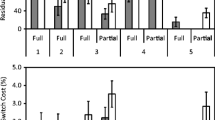Abstract
An experiment is reported that investigated switching among two numerical judgment tasks with a factorial variation of the cue-to-task mapping (1:1 vs. 2:1) for each of the tasks. In addition, the precuing interval (CSI) was varied. The results suggest that with a long CSI of 1,100 ms, switching performance is almost completely determined by the task-specific conditional probability of a task switch given a cue switch. This effect probably reflects the complexity of task-rule retrieval. Without preparation (CSI = 0 ms), the complexity of cue disambiguation as a function of the number of cues across tasks seems to account for most part of the additional variance observed in this condition. The latter observation is in line with suggestions that increasing the number of cues per task from one to two introduces additional demands on the level of cue processing that reflect the transition from an isomorphic to a homomorphic mapping function.

Similar content being viewed by others
Notes
Analyzing only the first block of trials in terms of a between-participants variation of the cue-to-task mapping yielded basically the same pattern of results.
References
Altmann, E. M. (2006). Task switching is not cue switching. Psychonomic Bulletin and Review, 13, 1016–1022.
Arrington, C. M., Logan, G. D., & Schneider, D. W. (2007). Separating cue encoding from target processing in the explicit task-cuing paradigm: are there true task switch effects? Journal of Experimental Psychology: Learning Memory and Cognition, 33, 484–502.
Gade, M., & Koch, I. (2007). Cue-task associations in task switching. The Quarterly Journal of Experimental Psychology, 60, 762–769.
Gallistel, C. R. (1989). Animal cognition: the representation of space, time and number. Annual Review of Psychology, 40, 155–189.
Grange, J. A., & Houghton, G. (2010). Heightened conflict in cue-target translation increases backward inhibition in set switching. Journal of Experimental Psychology: Learning, Memory, and Cognition, 36, 1003–1009.
Koch, I. (2003). The role of external cues for endogenous advance reconfiguration in task switching. Psychonomic Bulletin and Review, 10, 488–492.
Logan, G. D., & Bundesen, C. (2003). Clever homunculus: Is there an endogenous act of control in the explicit task-cuing procedure? Journal of Experimental Psychology: Human Perception and Performance, 29, 575–599.
Logan, G. D., & Schneider, D. W. (2006). Interpreting instructional cues in task switching procedures: the role of mediator retrieval. Journal of Experimental Psychology: Learning, Memory, and Cognition, 32, 347–363.
Mayr, U. (2006). What matters in the cued task-switching paradigm: tasks or cues? Psychonomic Bulletin and Review, 13, 794–799.
Mayr, U., & Kliegl, R. (2003). Differential effects of cue changes and task changes on task-set selection costs. Journal of Experimental Psychology: Learning, Memory, and Cognition, 29, 362–372.
Meiran, N. (1996). Reconfiguration of processing mode prior to task performance. Journal of Experimental Psychology: Learning, Memory, and Cognition, 22, 1423–1442.
Monsell, S., & Mizon, G. A. (2006). Can the task-cuing paradigm measure an endogenous task-set reconfiguration process? Journal of Experimental Psychology: Human Perception and Performance, 32, 493–516.
Schneider, D. W., & Logan, G. (2006). Priming cue encoding by manipulating transition frequency in explicitly cued task switching. Psychonomic Bulletin and Review, 13, 145–151.
Schneider, D. W., & Logan, G. D. (2011). Task-switching performance with 1:1 and 2:1 cue-task mappings: not so different after all. Journal of Experimental Psychology: Learning, Memory, and Cognition (in press).
Vandierendonck, A., Liefooghe, B., & Verbruggen, F. (2010). Task switching: interplay of reconfiguration and interference control. Psychological Bulletin, 136, 601–626.
Acknowledgments
Thanks to Stefan Arnau for assistance in programming and Jannis Bille for running the experiment. Additional thanks to James Grange and Andrea Philipp for their helpful comments on an earlier version of this article. The research reported in this article was supported by grant KL 1205/6-1 of the Deutsche Forschungsgemeinschaft.
Author information
Authors and Affiliations
Corresponding author
Rights and permissions
About this article
Cite this article
Kleinsorge, T. Task switching with a 2:1 cue-to-task mapping: separating cue disambiguation from task-rule retrieval. Psychological Research 76, 329–335 (2012). https://doi.org/10.1007/s00426-011-0344-5
Received:
Accepted:
Published:
Issue Date:
DOI: https://doi.org/10.1007/s00426-011-0344-5




